7 August 2024 : Daily Current Affairs
1. Earthquake 2,500 years ago abruptly changed Ganga river’s course
- 1. Earthquake 2,500 years ago abruptly changed Ganga river’s course
- 2. On the physics of pressure: how the microscopic world interacts with us
- 3. Proposed Amendments to Disaster Management Act: Key Enhancements and Unaddressed Issues
- 4. Punjab Proposes Rs 2,300 Crore Malwa Canal to Address Irrigation Needs Amid Funding and Feasibility Concerns
- 5. Cultivation of Genetically Modified crops
- Prelims Facts
- 1. Judicious use of sucralose as sugar substitute helps diabetics: study
- 2. Bangladesh students ask Yunus to lead for now
- 3. Significance of Teej
- 4. Global Stock Markets Plummet as Yen Carry Trade Unwinds Amid Economic and Geopolitical Concerns
- 5. Senior Citizens Drive Significant Costs Under Ayushman Bharat Scheme, Expansion Poses Financial Challenges
- 6. New Blue Revolution
- 7. PM-KUSUM SCHEME
(Source – The Hindu, International Edition – Page No. – 7)
| Context |
|
Key Findings from the 2024 Study on River Avulsion and Earthquakes
Discovery of Ancient River Avulsion:
- A recent study focused on the Ganges delta in Bangladesh revealed that the Ganga River abruptly changed its course about 2,500 years ago.
- This significant river avulsion was identified through an examination of an ancient paleochannel and two large sand dikes discovered nearby.
| River Avulsion: |
|

Evidence of Earthquake-Induced Avulsion:
- The sand dikes, formed by liquefaction—a process where sediments flow like a liquid due to earthquake disturbance—provided evidence of a major earthquake occurring around the same time as the river avulsion.
- Optically Stimulated Luminescence (OSL) dating of mineral samples from the paleochannel and sand dikes confirmed that both events occurred simultaneously.
| Optically Stimulated Luminescence (OSL) Dating: |
|
Implications for Earthquake and River Dynamics:
- The study highlights that large earthquakes can cause significant river avulsions, an impact that may be more devastating than previously understood.
- Historical avulsions have led to severe flooding, and such events are especially hazardous in densely populated regions like the Ganges-Meghna-Brahmaputra delta.
Future Risks and Considerations:
- The potential for earthquake-induced river avulsions is compounded by factors such as rapid subsidence, widespread embankments, rising sea levels, and extreme weather events linked to climate change.
- There is a call for increased research to understand the frequency of quake-driven avulsions and the development of forecasting methods.
Preparation and Coordination:
- Effective risk management requires collaborative efforts among India, Bangladesh, and Myanmar for research, monitoring, and preparedness.
- Understanding and preparing for the risks of earthquake-induced avulsions are crucial for mitigating future impacts on vulnerable regions.
| Practice Question: Discuss the significance of the Ganga river system for India’s economy and environment. How do factors such as climate change and urbanisation impact its sustainability? Provide examples of recent challenges and suggest measures for their mitigation. (150 Words /10 marks) |
2. On the physics of pressure: how the microscopic world interacts with us
(Source – The Hindu, International Edition – Page No. – 11)
| Topic: GS3 – Science and Technology |
| Context |
|
Understanding the pressure:
- Definition: Pressure is the force exerted per unit area. It’s the result of countless microscopic interactions between atoms and molecules.
Units of Measurement:
- Newton (N): Unit of force; e.g., an apple exerts about 1 N of force.
- Pascal (Pa): Unit of pressure; 1 Pa = 1 N/m². For instance, the pressure exerted by a single apple is approximately 500 Pa.
Atmospheric Pressure:
- The air pressure at sea level is around 100,000 Pa, equivalent to the weight of about 200 apples on your hand.
- It is caused by the weight of the air above us, extending up to the edge of space.
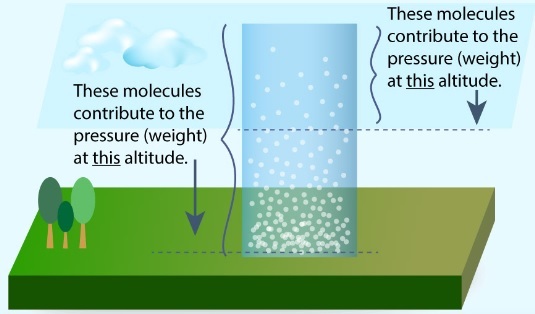
Pressure in Fluids:
- Fluids, including blood, exert pressure. Blood pressure is measured in millimetres of mercury (mm Hg). Normal blood pressure is about 120/80 mm Hg, where 120 mm Hg is the pressure during heartbeats and 80 mm Hg is the pressure between beats.
Pressure Measurement:
- Blood pressure is measured using a sphygmomanometer, which originally used a column of mercury.
- Mercury is chosen because it’s denser than water, making it practical for measuring pressure in smaller, portable devices.

Pressure Cooker application:
- In a pressure cooker, water is heated to increase its pressure, cooking food faster by making water molecules more energetic and effective in breaking molecular bonds in food.
Everyday Implications:
- Pressure is ubiquitous in daily life, affecting everything from cooking to driving. It plays a crucial role in various physical processes and technologies.
3. Proposed Amendments to Disaster Management Act: Key Enhancements and Unaddressed Issues
(Source: Indian Express; Section: Explained; Page: 25)
| Topic: GS2 – Governance |
| Context: |
|
What is NDMA act?
The DM Act was passed by the government of India in 2005 for the ‘efficient management of disasters and other matters connected to it. However it came into force in January 2006.
Objective:
- To manage disasters, including preparation of mitigation strategies, capacity-building and more.
- Definition of a “disaster” in Section 2 (d) of the DM Act states that a disaster means a “catastrophe, mishap, calamity or grave occurrence in any area, arising from natural or man made causes.
Significance of the DM Act
- Enacted after the 2004 tsunami, the DM Act established critical institutions like the NDMA, SDMAs, NDRF, and NIDM.
- These bodies have been instrumental in managing natural disasters, saving lives, and providing relief.
- However, the increasing frequency and intensity of disasters necessitate further strengthening of these institutions.
Proposed Amendments
- Urban Disaster Management Authorities: The Bill proposes the creation of Urban Disaster Management Authorities for large metropolitan cities, headed by municipal commissioners. This aims to provide a coordinated response to urban-specific disasters like flooding.
- State Disaster Response Forces (SDRF): The Bill mandates the establishment of SDRFs in every state, standardizing disaster response capabilities across the country.
- National Crisis Management Committee (NCMC): The NCMC, led by the Cabinet Secretary, will be given legal status as the nodal body for handling national disasters, enhancing its authority and efficiency.
- Enhanced Role of NDMA: The NDMA’s responsibilities will expand to include periodic assessments of disaster risks and the creation of a national disaster database. This will aid in better preparation and response strategies.
- Compensation Guidelines: The NDMA will set guidelines for minimum standards of relief, including compensation for loss of life, property damage, and livelihoods.
- Clarification on Man-Made Disasters: The Bill clarifies that “man-made causes” do not include law-and-order situations, thus excluding incidents like riots from the Act’s purview.
- Vice-Chairperson Role: The Bill legitimizes the vice-chairperson’s position, allowing for the day-to-day functioning to be managed by a designated member if the vice-chairperson is absent.
Unaddressed Issues
Despite these improvements, the Bill misses several key opportunities:
- Institutional Status of NDMA: The NDMA’s institutional status remains unchanged. Elevating it to a government department or ministry would enhance its coordination capabilities and resource allocation.
- Leadership and Administrative Powers: The NDMA lacks a vice-chairperson and sufficient leadership, reducing its effectiveness in dealing with states and central agencies. It also lacks administrative and financial powers, leading to inefficiencies.
- Staffing Shortages: The NDMA is understaffed, operating with only three members. This limits its capacity to manage various disaster types effectively.
Conclusion
- The proposed amendments to the DM Act aim to enhance India’s disaster management framework significantly.
- However, to fully realize these improvements, addressing the unaddressed issues related to the NDMA’s institutional status, leadership, and administrative powers is crucial.
- These changes would ensure a more robust and efficient disaster response system, better equipped to handle the increasing challenges posed by natural and man-made disasters.
| Practice Question: Evaluate the proposed amendments to the Disaster Management Act, 2005, focusing on their potential to enhance operational efficiency and address gaps in disaster management. Discuss the significance of these changes and identify any key issues that remain unaddressed. (250 words/15 m) |
4. Punjab Proposes Rs 2,300 Crore Malwa Canal to Address Irrigation Needs Amid Funding and Feasibility Concerns
(Source: Indian Express; Section: Cover Page; Page: 01)
| Topic: GS3 – Indian Economy – Infrastructure |
| Context: |
|
Analysis of News:
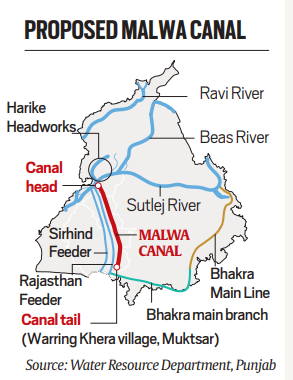
Background and Proposal:
- Punjab plans to build a 149.53-km irrigation canal, named the Malwa canal, for Rs 2,300 crore.
- The canal will start at Harike Headworks on the Sutlej river in Ferozepur and end at Warring Khera village in Muktsar.
- It will be 50 feet wide, 12 feet deep, and carry 2,000 cusecs of water.
- The canal aims to irrigate 2 lakh acres in seven districts, improving water supply during the kharif season.
Need:
- The canal will supplement the left side of the Rajasthan Feeder canal, which the Sirhind Feeder cannot effectively serve.
- It addresses the irrigation needs of areas struggling due to insufficient and polluted groundwater. Ensures water supply to Abohar, Fazilka, Muktsar, Gidderbaha, Bathinda, and Zira.
- Expected to benefit around 190 villages, eliminating the need for rotational canal usage.
Challenges:
- Punjab faces a severe funds crunch with a debt burden of Rs 3.5 lakh crore.
- Hostility between the central and state governments makes central funding unlikely.
- Environmental clearance, land acquisition, and technical feasibility issues, such as water levels and the need for lift systems, pose additional challenges.
- Critics argue there isn’t enough water to justify the new canal, given current rotational usage of existing canals.
| Practice Question: Examine the potential benefits and challenges associated with Punjab’s proposed Malwa canal project. Discuss the financial, technical, and environmental considerations that the state government must address to ensure the project’s viability. (250 words/15 m) |
5. Cultivation of Genetically Modified crops
(Source – https://pib.gov.in/PressReleseDetail.aspx?PRID=2042234 )
| Topic: GS3 – Agriculture |
| Context |
|


Analysis of the news:
- Bt. cotton is the only genetically modified crop approved in India for commercial cultivation since 2002 by the Genetic Engineering Appraisal Committee (GEAC) of the Ministry of Environment, Forest and Climate Change.
| Genetic Engineering Appraisal Committee (GEAC): |
|
- The Indian Council of Agricultural Research (ICAR) – Central Institute for Cotton Research (CICR), Nagpur, evaluated the impact of Bt. cotton in Maharashtra for the years 2012-13 and 2013-14.
Advantages of Bt. Cotton As per the study:
- Effective Pest Control: Bt. cotton significantly reduces bollworm infestation, a major pest, leading to healthier crops and lower damage.
- Reduced Insecticide Use: Farmers experience a decrease in insecticide applications from 8 to 4, lowering costs and minimising environmental impact.
- Increased Crop Yields: Adoption of Bt. cotton results in higher yields, with a difference of 3-4 quintals per acre compared to non-Bt. cotton.
- Higher Income for Farmers: Increased yields and reduced insecticide costs contribute to a rise in income, estimated at Rs. 25,000 per hectare under rainfed conditions.
- No Adverse Soil Effects: Studies show that Bt. Cotton cultivation does not negatively affect soil ecological parameters.
- Widespread Adoption: Over 96% of cotton cultivation area is occupied by Bt. cotton, indicating its acceptance and effectiveness among farmers.
- Enhanced Agricultural Sustainability: Bt. cotton supports sustainable farming practices by integrating pest resistance and reducing reliance on chemical inputs.
| Practice Question: Discuss the impact of Bt. cotton on agricultural productivity and environmental sustainability in India. Highlight key benefits and challenges based on recent studies. (150 Words /10 marks) |
Prelims Facts
1. Judicious use of sucralose as sugar substitute helps diabetics: study
(Source – The Hindu, International Edition – Page No. – 4)
| Context |
|
Analysis of the news:
- A recent Indian study investigated the effects of replacing sucrose with sucralose in coffee and tea on individuals with Type 2 Diabetes (T2D).
- The study, titled “Effect of replacing sucrose in beverages with non-nutritive sweetener sucralose on cardiometabolic risk factors among Asian Indian adults with Type 2 Diabetes: a 12-week randomised controlled trial,” was published in Diabetes Therapy in late July.
- Conducted over 12 weeks, the trial involved 210 participants with T2D, divided into an intervention group using sucralose and a control group continuing sucrose use.
- Primary outcomes focused on changes in HbA1c levels (Glycated Hemoglobin), showing no significant difference between groups.
- Secondary outcomes indicated slight improvements in body weight, BMI, and waist circumference for the sucralose group.
- The study, led by Dr. V. Mohan, aimed to address concerns about artificial sweeteners amidst WHO warnings against non-nutritive sweeteners (NNS) for non-diabetics.
- Dr. Mohan emphasised the benefits of NNS in reducing caloric intake without impacting glucose control, countering negative publicity against sweeteners.
- Further research is planned to explore sucralose’s safety and efficacy.
| Sucralose |
|
2. Bangladesh students ask Yunus to lead for now
(Source – The Hindu, International Edition – Page No. – 1)
| Context |
|
Who is Muhammad Yunus?
- Muhammad Yunus, a Bangladeshi social entrepreneur, was awarded the Nobel Peace Prize in 2006 for his pioneering work in microfinance.
- He is best known for founding the Grameen Bank in 1983, which provides small loans to impoverished individuals, primarily women, without requiring collateral.
- This innovative approach has empowered millions, fostering economic development and self-sufficiency in developing countries.
- Yunus’s model of microcredit has been widely adopted, transforming lives and influencing global financial systems. His work extends beyond microfinance, advocating for social business and sustainable development.
- Yunus’s contributions have significantly impacted poverty alleviation efforts, earning him global recognition and accolades.
Mohammed Yunus and Amartya Sen
- Muhammad Yunus and Amartya Sen collaborated on various social and economic issues, notably in promoting the concept of social business and poverty alleviation.
- Both have significantly influenced the discourse on development economics, with Yunus focusing on microfinance and Sen on capabilities and welfare economics.
- Their combined efforts have advanced understanding and strategies for addressing global poverty.
3. Significance of Teej
(Source – The Hindu, International Edition – Page No. – 6)
| Context |
|
Analysis of the news:
- Teej is a festival deeply rooted in Hindu mythology and is closely related to the worship of Goddess Parvati and her union with Lord Shiva.
- It signifies devotion, marital bliss, and the power of penance.
- The festival’s primary focus is on the bond between husband and wife, with married women observing fasts and rituals for the prosperity and longevity of their husbands, while single women pray for a suitable life partner.
- Teej also celebrates the monsoon season, symbolising fertility and renewal.
- The lush greenery during this period is commemorated, reflecting the abundance and vitality of nature.
- The festival involves various rituals, including fasting, chanting hymns, and storytelling about Parvati’s devotion and trials.
4. Global Stock Markets Plummet as Yen Carry Trade Unwinds Amid Economic and Geopolitical Concerns
(Source: Indian Express; Section: Explained; Page: 25)
| Context |
| Major global stock markets faced significant declines due to various factors, including the increasing odds of a US recession, geopolitical tensions in West Asia, and the unwinding of the yen carry trade. |
Analysis of News:

What is Yen Carry Trade:
- Definition: Investors borrow money in a low-interest-rate country (Japan) and invest in higher-interest-rate countries (e.g., Brazil, India, US) to earn better returns.
- Japanese Rates: The Bank of Japan kept interest rates at 0% (2011-2016) and below zero (-0.10%) since 2016 to stimulate economic activity.
- Global Impact: Japan’s low rates led to widespread yen carry trades, fueling investments globally.
Recent Changes:
- Rate Hike: From mid-March to July-end, the Bank of Japan raised interest rates by 35 basis points to 0.25%, a significant increase in Japan’s context.
- Impact: This led to the unwinding of yen carry trades, causing investors to sell assets in currencies like the Indian rupee.
Investor Reaction:
- Stronger Yen: Higher interest rates strengthened the yen against other currencies, reducing the value of assets held in those currencies when converted back to yen.
- Higher Opportunity Cost: Increased returns on yen investments led to a narrowing of the yield differential, prompting investors to sell off assets bought with cheap yen.
5. Senior Citizens Drive Significant Costs Under Ayushman Bharat Scheme, Expansion Poses Financial Challenges
(Source: Indian Express; Section: Economy; Page: 15)
| Context: |
| The article sheds light on Ayushman Bharat health insurance scheme. |
Analysis of News:
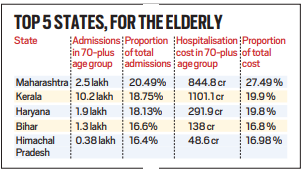
What is Ayushman Bharat-PMJAY?
- PM-JAY is the world’s largest health insurance scheme fully financed by the government.
- Launched in 2018, it offers a sum insured of Rs.5 lakh per family for secondary care and tertiary care.
- Health Benefit Packages covers surgery, medical and day care treatments, cost of medicines and diagnostics.
Key Statistics:
- Beneficiaries aged 70+ made up 12% of admissions under Ayushman Bharat, accounting for nearly 14% of total costs.
- Of 6.2 crore hospital admissions till January 2024, 57.5 lakh were for those 70+.
- Government expenditure on these admissions totaled Rs 9,878.5 crore out of Rs 79,200 crore over six years.
Challenges:
- The Government plans to expand Ayushman Bharat to include all individuals over 70, potentially adding 4 crore beneficiaries.
- This expansion could be costlier than covering the poorest 40% due to higher healthcare utilization and premiums for older individuals.
Expert Opinion:
- Experts notes affluent older individuals seek more healthcare, increasing policy utilization and costs.
Current Budget and Future Needs:
- Interim budget expanded coverage for ASHA and Anganwadi workers; no further expansion was mentioned in the full budget.
- Insurance scheme allocation increased only by Rs 100 crore to Rs 7,300 crore.
Demographic Impact:
- India’s population over 60 is projected to rise from 8.6% in 2011 to 19.5% by 2050, with absolute numbers tripling from 103 million to 319 million.
State-Level Data:
- Several states saw hospital admissions for those 70+ exceed their population share, led by Maharashtra (20.49%), Kerala (18.75%), and Haryana (18.13%).
6. New Blue Revolution
(Source – https://pib.gov.in/PressReleseDetail.aspx?PRID=2042167 )
| Topic: GS2 – Governance – Government policies |
| Context |
|
The New Blue Revolution:
- Overview: The New Blue Revolution aims to boost the fisheries and aquaculture sector in India with a focus on sustainable and responsible practices.
Pradhan Mantri Matsya Sampada Yojana (PMMSY):

- Duration: 2020-21 to FY2024-25.
- Investment: ₹20,050 crore.
- Financial Assistance: Up to 40% for general beneficiaries and 60% for SC/ST/Women.
- Components: Pond and tank construction, hatcheries, technology infusion (e.g., Re-circulatory Aquaculture System, Bio-floc systems), seaweed and bivalve cultivation, fish transport infrastructure, cold storage, fish feed mills, value-added enterprises, and trout farming support.
- Fisheries and Aquaculture Infrastructure Development Fund (FIDF):
- Total Fund: ₹7,522.48 crore.
- Support: Concessional finance and interest subvention up to 3% for 12 years.
- Focus: Development of fisheries infrastructure, including trout farming facilities.
- Pradhan Mantri Matsya Kisan Samridhi Sah Yojana (PMMKSSY):
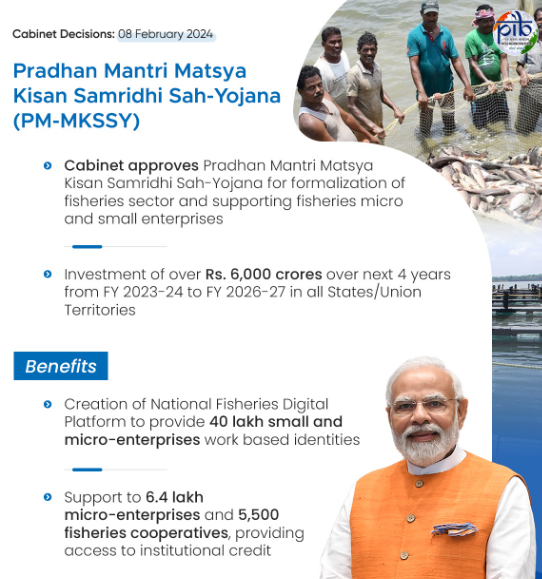
- Investment: ₹6,000 crore.
- Objectives: Formalization of the sector, incentivizing aquaculture insurance, improving value chain efficiency, and ensuring safety and quality.
- Kisan Credit Card (KCC):
- Extension: Since 2018-19 for fishers and fish farmers.
- Purpose: Meets working capital requirements for fisheries and aquaculture activities.
| Practice Question: Discuss the objectives and impact of the New Blue Revolution in India’s fisheries and aquaculture sector. (150 Words /10 marks) |
7. PM-KUSUM SCHEME
(Source – https://pib.gov.in/PressReleseDetail.aspx?PRID=2042069 )
| Topic: GS2 – Governance – Government policies |
| Context |
|
PM-KUSUM scheme
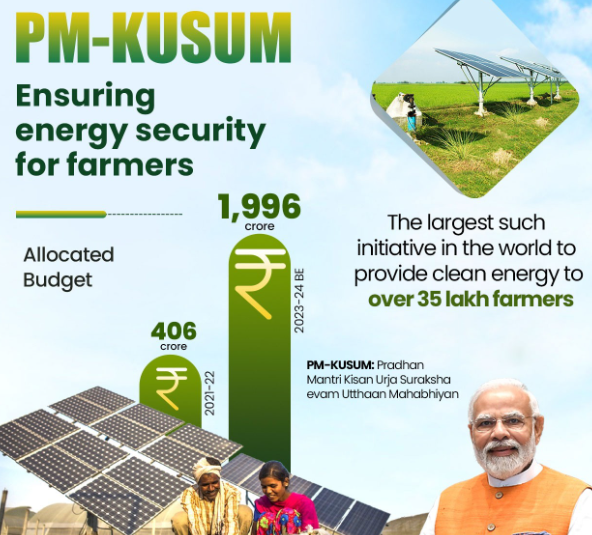
- Launch and Scaling: PM-KUSUM scheme launched in March 2019, scaled up in January 2024.
- Ministry: Ministry of New and Renewable Energy (MNRE)
- Objectives:
- Provide energy and water security to farmers.
- Enhance farmer income.
- De-dieselize the farm sector.
- Reduce environmental pollution.
- Component-A:
- Purpose: Set up Decentralized Ground/Stilt Mounted Grid Connected Solar or other Renewable Energy based Power Plants on farmers’ land.
- Capacity: Up to 2 MW.
- Implementation: Can be done by farmers themselves, or in partnership with cooperatives, panchayats, FPOs, or developers.
- Financials: Renewable energy purchased by DISCOMs at pre-fixed tariffs; land lease payments if leased to developers.
- Incentives: DISCOMs receive Performance Based Incentive (PBI) of Rs. 0.40 per unit or Rs. 6.6 lakh per MW for five years, which can be passed to REPP owners for better tariffs.
- Component-B:
- Purpose: Install Stand-alone Solar Agriculture Pumps.
- Central Financial Assistance (CFA): 30% (50% for North Eastern Region/Hilly regions/Islands).
- Component-C:
- Purpose: Solarisation of grid-connected Agriculture Pumps under Individual Pump Solarisation (IPS) and Feeder Level Solarisation (FLS).
- Central Financial Assistance (CFA): 30% (50% for North Eastern Region/Hilly regions/Islands).
- Beneficiaries:
- As of 30.06.2024, 4,11,222 farmers benefited nationwide.
- Uttar Pradesh alone has benefited 51,097 farmers as of 29.07.2024.



